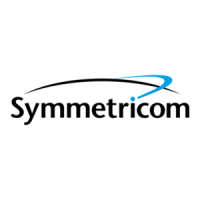Chapter 3 Provisioning and Operating the SSU-2000e
Controls and Indicators
90 SSU-2000e User’s Guide 12713140-002-2 Revision E – October 2006
Controls and Indicators
SSU-2000e Status LED Indicators
All modules used in the SSU-2000e main chassis and in the optional SDU-2000e
expansion chassis contain status LED indicators that provide a visual indication of
module status. The Communications module provides both system and individual
module status whereas all other modules provide individual module status only. For
more information on individual module status LED indicators, refer to SSU-2000e
Turn-Up Procedures, on page 85, and Chapter 6, Clock Module Reference Data,
Chapter 7, Input Module Reference Data, and Chapter 8, Output Module Reference
Data.
SSU-2000e Operating Controls
The SSU-2000e contains three hardware operating controls:
Two DCE/DTE select switches associated with the three EIA-232 ports. One
switch is located on the front of the Communications module and the second
switch (S1) is located on the SSU-2000e connection panel. The DTE position is
for connection to a PC and the DCE position is for connection to a modem.
Reset (RST) switch on the Communications module.
Establishing a Connection With the SSU-2000e
You can connect to the SSU-2000e using either a serial connection or an Ethernet
connection. To connect via a serial port, see Communicating by Serial Port, on page
91. If the SSU-2000e is connected to an Ethernet LAN, use the procedure
described in Communicating by Ethernet, on page 92. Refer to Table 3-1 for the
serial and Ethernet communications port assignments.
Table 3-1. Communications Port Assignments
Port # Function Protocol
Serial Ports (EIA-232)
A (J4) This port is user selectable as either an ICS or a TL1
interface. The port defaults to ICS upon initialization
ICS (Default), TL1
B (J5) This port is user selectable as either an ICS or a TL1
interface. The port defaults to ICS upon initialization
ICS (Default), TL1
Local
(Comms Module)
This port is user selectable as either an ICS or a TL1
interface. The port defaults to ICS upon initialization
ICS (Default), TL1

